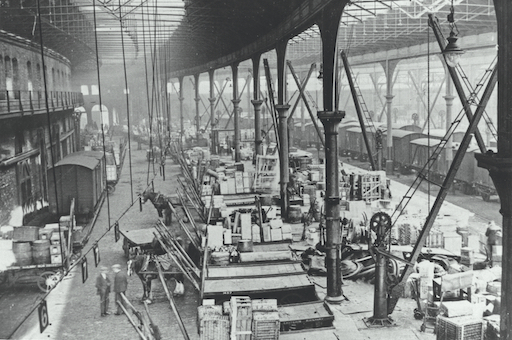
Station Hall
Horses in the Goods Station

Horse carts backed up against a goods station platform, Newcastle, 1920s. Private collection, B Fawcett.
Located as we are, in one of Britain’s best-preserved former goods stations, it’s important that we acknowledge the work of some of the most vital members of York railway’s team. From the building’s opening in 1877, right up to the early 1950s, they were imperative to the successful distribution of goods across the country. In fact, you may be able to hear them transporting a wagonload of freight behind us now. These unlikely heroes are of course, our railway horses.
These living, breathing creatures were the white vans of their day, with one simple task: to move heavy carts and wagons into the station and out to the city. On this side of the building, it would be common to see a long line of them backed up against the platform, like vehicles in a supermarket car park, waiting patiently for goods to be loaded into their carts behind. Imagine them standing in front of us as we cast our eyes across the site.
Horses were the perfect choice for the railway. Happy to work so long as they were well-rested and fed, the complex at York had a range of facilities to accommodate their needs. These included stables, a harness-room, a blacksmith’s workshop, a shoeing forge, and a horse-keeper’s house. We can still see the stables on our site today. Built around a courtyard on the edge of the goods station, look out for a large brick building located on Leeman Road.
As technology advanced rapidly in the 1920s, horses were slowly replaced by motorised alternatives that didn’t need feeding in order to operate. By the early 1950s the sight of working horses in the goods station was a thing of the past. But their legacy has lived long in the memory of those that worked here. For over seventy years, these beautiful animals were essential to the success of York’s transportation network, creating a lasting relationship that could never be replicated by their mechanical successors.